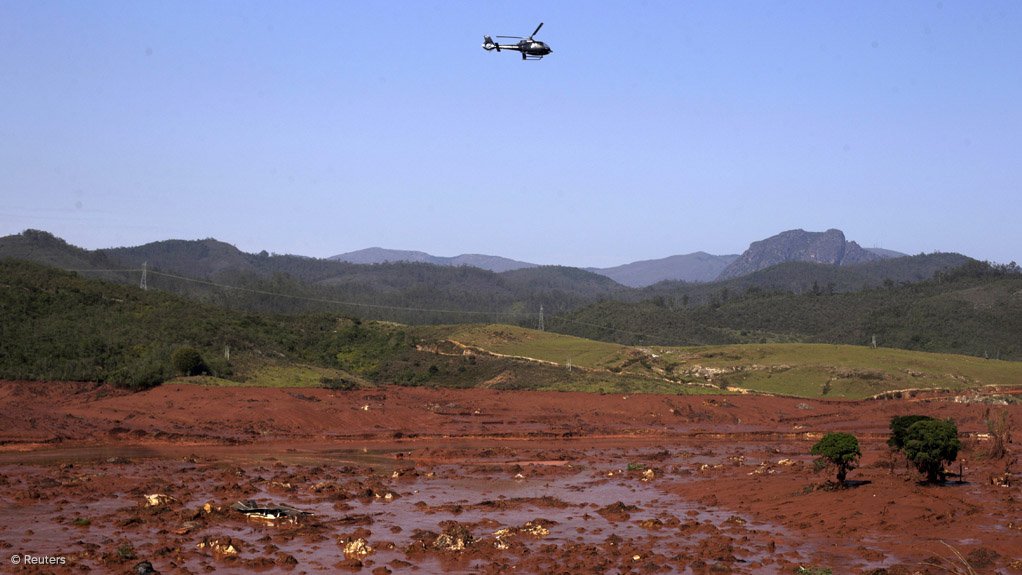Beleaguered Brazilian miners set great store by new President – KPMG



SAMARCO SCARS This incident has been described by analysts as ‘the worst environmental disaster’ in Brazilian history
Photo by Reuters
PIETER VAN DIJK Mining contributes about 5% to Brazil’s gross domestic product and the country’s largest mining company is diversified mining major Vale
The mining sector in Brazil, like most others worldwide, is currently facing many difficulties, principally owing to weak commodity prices. However, mining companies are hopeful that the country’s recently appointed President, Michel Temer, will support efforts to strengthen the country’s mining industry, says professional services firm KPMG Brazil mining and metals head Pieter Van Dijk.
Following the impeachment of former President Dilma Rousseff on August 31, Temer succeeded her as President of the country. His term is set to end in January 2019.
Van Dijk highlights that the almost year-long impeachment process of Rousseff and the country’s current economic situation have “caused great political and social instability” in Brazil and severely dented investor confidence in South America’s largest country.
He points out that Brazil’s government has for some time been discussing the introduction of a new mining regulatory code, which was sent to Congress for approval in 2013. However, it did not receive assent then and has not subsequently, largely as a result of the political instability in Brazil owing to the Rousseff impeachment process.
Van Dijk notes that a proposed mining code was drafted in 2011 and was premised on the state of the global mining sector at the time, which was experiencing a boom. Therefore, it called for a significant increase in mineral royalty payments (of up to 4%) to ensure the State benefited fairly from its mineral resources.
However, Van Dijk says that the new mining code reflects the current economic and commodity price realities. Hence, there will in fact be reductions in mineral royalty rates and the new code is anticipated to be approved during the course of the first half of 2017.
Brazil is the second-largest producer of iron-ore worldwide behind only Australia. It is also the largest producer of niobium and tantalum. Brazil is also the third-largest producer of bauxite and graphite and the fifth-largest producer of magnesium.
Van Dijk highlights that mining accounts for about 5% of Brazil’s gross domestic product (GDP) and that the country’s largest mining company is diversified mining major Vale, which is responsible for about 70% of all revenue generated in the country’s mining sector.
He says that the company’s primary commodity is iron-ore and, with substantial declines in the price of iron-ore over the past three years, this has significantly impacted on the company’s profitability levels and, therefore, investment decisions.
“It is for these reasons that Vale is currently undertaking a cost reduction and optimisation programme, scaling back on future project investments and selling off a number of its noncore assets,” Van Dijk remarks.
Research firm BMI, a unit of Fitch Group, estimates that the current value of Brazil’s mining industry is $43.4-billion.
The firm believes that iron-ore will be Brazil’s mining industry’s “growth bright spot” owing to the sector’s low production costs and as result of a strong output growth strategy from Vale.
“We expect Brazil’s share of global iron-ore production to increase from 14.4% in 2016 to 17.7% by 2020, with the sector’s output reaching 581-million tons in 2020 from 454-million tons in 2016,” states BMI.
The research company remarks that investment and merger and acquisition activity will pick up in Brazil’s mining sector as debt-laden firms seek to offload prime assets. “Most notably, in April, diversified miner Anglo American sold its niobium and phosphate business in Brazil to Chinese firm China Molybdenum for $1.5-billion. Additionally, in May, Canadian miner Yamana Gold announced the $52-million purchase of the Riacho dos Machados gold project, in Minas Gerais, Brazil, from exploration and development company Carpathian Gold.”
Further, BMI states that Brazil’s nickel and tin production growth will “remain muted” over the coming years owing to weak prices. The firm notes that, in the second quarter of 2016, Brazilian miner Votorantim Metais reported a 44% decline in nickel sales volumes in the quarter, owing to the temporary suspension of operations, which were implemented in June. BMI adds that a lack of new tin projects will “keep a lid” on Brazil’s tin production outlook.
Meanwhile, Van Dijk points out that mining is primarily undertaken in two states in Brazil, namely Minas Gerais and Pará. Vale’s principal assets are located in Pará, including the $37-billion Carajás S11D iron-ore project, which aims to be a high-quality, low-cost producing mine.
He adds that Anglo American continues to ramp up production at its Minas-Rio iron-ore mining project, in Minas Gerais. According to the diversified miner, its plans are for the mine’s output to reach between 18-million tons and 21-million tons by the end of the 2016 financial year and between 21-million tons and 23-million tons in the 2017 financial year, reaching its full 26.5-million-ton production capacity by 2018.
In November 2015, an iron-ore tailings dam in Bento Rodrigues, in Mariana, collapsed, causing flooding which resulted in 19 deaths, a number of injuries and substantial damage to nearby properties and the environment. This incident has therefore been described by analysts as “the worst environmental disaster in Brazil’s history”.
The dam is a property of Samarco, a joint venture (JV) between diversified mining majors Vale and BHP Billiton. A 76-page report commissioned by the JV partners, has attributed the dam burst to a chain of events dating back to 2009, but it did not assign blame or highlight specific errors in corporate or regulatory practice.
A separate police investigation has accused Samarco of “wilful misconduct”, saying the company ignored clear signs the dam was at risk of collapsing. Samarco denies any wrongdoing.
Nonetheless, in February, Vale and BHP reached an agreement with the Brazilian government to pay $5.1-billion in damages for the spill. However, the agreement is being highly criticised by civil society organisations for not being transparent and not involving the people actually affected by the collapse.
On September 14, a Brazilian judge ordered three independent damage assessments of the November 2015 Samarco mine tailings dam burst. The results will inform the ongoing federal lawsuit against Vale and BHP Billiton, as prosecutors are looking to overturn the settlement agreement as inadequate.
Further, Brazilian federal prosecutors have filed criminal charges against BHP and some of its current and former employees, as a result of the tragedy. However, BHP has said it will defend charges against the company and the affected individuals.
Comments
Press Office
Announcements
What's On
Subscribe to improve your user experience...
Option 1 (equivalent of R125 a month):
Receive a weekly copy of Creamer Media's Engineering News & Mining Weekly magazine
(print copy for those in South Africa and e-magazine for those outside of South Africa)
Receive daily email newsletters
Access to full search results
Access archive of magazine back copies
Access to Projects in Progress
Access to ONE Research Report of your choice in PDF format
Option 2 (equivalent of R375 a month):
All benefits from Option 1
PLUS
Access to Creamer Media's Research Channel Africa for ALL Research Reports, in PDF format, on various industrial and mining sectors
including Electricity; Water; Energy Transition; Hydrogen; Roads, Rail and Ports; Coal; Gold; Platinum; Battery Metals; etc.
Already a subscriber?
Forgotten your password?
Receive weekly copy of Creamer Media's Engineering News & Mining Weekly magazine (print copy for those in South Africa and e-magazine for those outside of South Africa)
➕
Recieve daily email newsletters
➕
Access to full search results
➕
Access archive of magazine back copies
➕
Access to Projects in Progress
➕
Access to ONE Research Report of your choice in PDF format
RESEARCH CHANNEL AFRICA
R4500 (equivalent of R375 a month)
SUBSCRIBEAll benefits from Option 1
➕
Access to Creamer Media's Research Channel Africa for ALL Research Reports on various industrial and mining sectors, in PDF format, including on:
Electricity
➕
Water
➕
Energy Transition
➕
Hydrogen
➕
Roads, Rail and Ports
➕
Coal
➕
Gold
➕
Platinum
➕
Battery Metals
➕
etc.
Receive all benefits from Option 1 or Option 2 delivered to numerous people at your company
➕
Multiple User names and Passwords for simultaneous log-ins
➕
Intranet integration access to all in your organisation




















